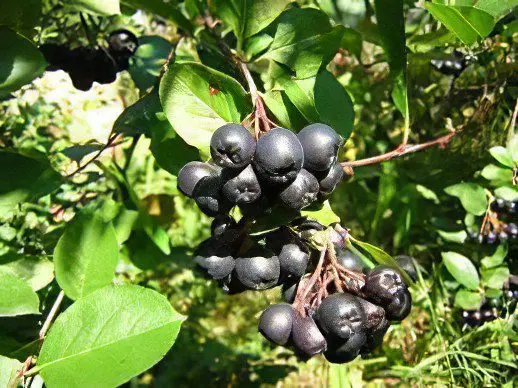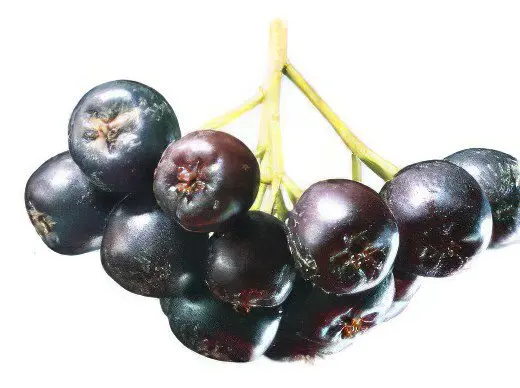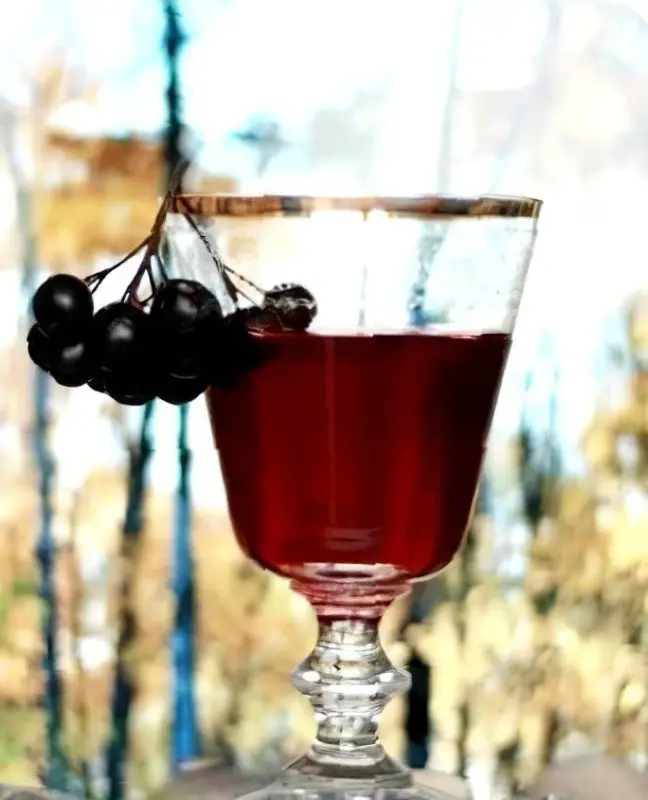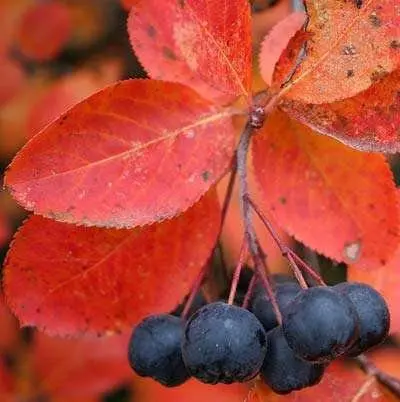Contents
- Botanical characteristics of black chokeberry
- Composition and calorie content
- Useful properties of chokeberry
- The use of chokeberry
- Aronia juice
- Aronia Recipes
- Chokeberry tincture
- Preparation of tincture
- Aronia varieties
- Reproduction of chokeberry
- Chokeberry syrup
- Aronia Siberian
- Aronia Michurina
- Aronia Viking
- Contraindications to the use of chokeberry
Botanical characteristics of black chokeberry

Aronia chokeberry is a perennial shrub with many branches. The young crown is small, becomes spreading with age, reaches a height of 2,5 meters, and a diameter of 1,5–2 m. The next leaves on short petioles are obovate and have a short sharp tip. The leaf has a leathery, glossy, dark green upper surface. The lower part of the leaf is slightly pubescent and whitish in color. In autumn, chokeberry leaves change color to bright purple-red tones.
The shrub has a beautiful flowering (May-June), bisexual white or pink flowers make up dense corymbose inflorescences. Spherical black fruits are covered with a wax coating, sour-sweet, with an astringent taste, juicy, collected in clusters. Ripe fruits (August-September) practically do not crumble, thanks to the dense skin they retain juiciness and freshness for a long time.
Aronia is native to North America, today this beautiful plant can be seen in many regions of the world. It is planted in gardens, parks, squares. The fruits are carefully cut and stored in boxes in a cool room, but the shelf life is limited, so they are mainly dried or made into jam, ground with sugar, etc.
Composition and calorie content
Calories 55 KKal
- Fats:
0,2 g
- Proteins:
1,5 g
- Carbohydrates:
15,0 g
- Water:
81,8 g
- Ash:
1,5 g
- Cellulose:
3,4 g
Vitamins | Quantity | % RDN |
Vitamin C (ascorbic acid) | 15-67 mg | 59% |
Beta-carotene | 1200-3600 μg | 48% |
Vitamin E (alpha tocopherol) | 0,8-2,2 mg | 10% |
Vitamin B5 (pantothenic acid) | 0,5 mg | 10% |
Minerals (in 100 g): | Quantity | %RDN |
Cobalt | 15 mcg | 150% |
Selenium | 22,9-36,3 μg | 46% |
Silicon | 10 mg | 33% |
Manganese | 500 mcg | 25% |
Vanadium | 9 mcg | 23% |
* Lead | 2 mcg | 20% |
Iodine | 5-47 μg | 17% |
Molybdenum | 8,7 mcg | 12% |
Hardware | 1,1-1,7 mg | 10% |
Full chemical composition ➤
Other important connections:
Phytosterols — 2 mg (3,6% of RDI)
Purine — 8 mg (6,7% of RDI)
Useful properties of chokeberry

Aronia fruits are a real storehouse of vitamin P and iodine compounds. Aronia is valued for the content of sorbitol, a natural sugar substitute: it can be used by people suffering from diabetes. The beneficial properties of the plant are very impressive: it contains pectin and tannins, ascorbic acid, citrine, carotene. The content of riboflavin, folic, malic and nicotinic acids contributes to the excellent prevention of prostate cancer, neurological diseases.
The substances contained in the fruits block the growth of cancer cells, negatively affect the formation and development of polyps. The presence of tocopherols, phylloquinones, pyridoxines, niacins, thiamines, important for many processes in the body, has also been proven. You can list the list of useful substances of chokeberry for a long time. Amygdalin, coumarin, rutin, quercetin, hesperidin, catechins, cyanidin and other compounds have a positive effect on human functional systems. Among the trace elements, iron, manganese, iodine, salts of molybdenum, boron, manganese and copper are distinguished.
The use of chokeberry

Aronia chokeberry belongs to honey plants; in folk medicine, its fruits and leaves are mainly used.
Aronia tea: 6 tablespoons of leaves should be poured with 1 liter of boiling water, insisted for half an hour. It is recommended to take the remedy 1 glass 3 times a day. This tea helps lower blood pressure, increase blood clotting.
Aronia decoction: to prepare a decoction that can strengthen the immune system, give strength and activate energy, you need to take 20 g of dried fruits, pour 200 ml of boiling water over them, simmer for 10 minutes, then leave for 20 minutes, strain, squeeze. Take a decoction 3-4 times a day for 0,5 cups.
Aronia infusion: 2-4 tablespoons of dried fruits insist in a thermos with two cups of boiling water. The next day, the infusion is consumed in 3 divided doses 20-40 minutes before meals.
The bark also has medicinal properties.
Aronia bark decoction: 5 tablespoons (with a slide) of crushed bark are required to be poured into 0,5 liters of water, boiled for 10 minutes, cooled, squeezed and taken as an anti-sclerotic agent, effective in atherosclerosis of the vessels.
Chokeberry is used for hemorrhagic syndrome, vitamin P has a vasoprotective effect. Berries are useful for radiation sickness, beriberi, for recovery after serious illnesses or operations. Endocrinologists advise using berries for disorders of the thyroid gland. Aronia is incredibly effective for the treatment and prevention of cardiovascular diseases, such as atherosclerosis and hypertension. It has a strengthening effect on blood vessels, relieves insomnia, normalizes metabolic processes and the immune system.
A useful plant helps to eliminate radioactive substances from the body, will help with various bleeding, capillary toxicosis. gastritis with low acidity, kidney disease, measles, typhus, scarlet fever can proceed without complications if miraculous berries are introduced into the diet. With a high vitamin content, chokeberry can help treat weeping eczema and other skin conditions. The use of folk remedies increases the body’s defenses, stimulates appetite and has a choleretic effect. It is recommended to take berries for mental fatigue.
Aronia juice
Aronia juice is taken at high and low pressure. A pleasant-tasting drink can provide the body with vitamins and microelements, increase resistance to colds, and stimulate the stomach, pancreas, and liver. But it must be remembered that chokeberry should not be used in acute ulcerative manifestations and gastritis with high acidity. Bioflavonoids, sorbitol and hydroxycinnamic acids exhibit a choleretic effect.
Recipe for chokeberry juice: to prepare natural juice, fresh fruits must be crushed, heated the finished pulp (1 kg per 0,5–0,75 cups of water) to 60 ° C for 10 minutes and put under pressure. Then the squeezed raw material should be placed in an enamel pan, pour boiled, slightly warm water (1:10), stand for 3-4 hours, stirring, and squeeze again. After you need to combine the juice of the first and second extraction, filter through cheesecloth, heat to 80–85 ° C, fill sterilized jars. First, you need to sterilize half-liter jars for 10 minutes, liter – 12-15 minutes, two-liter – 18-20 minutes.
Recommendation #1: 50 g of fresh juice with a tablespoon of honey should be consumed 3 times a day half an hour before meals for 10–45 days to treat hypertension.
Recommendation #2: drink black chokeberry juice 50 ml 3 times a day for 30 minutes. before meals for 10 days or 100 g of fresh fruits 3 times a day.
Aronia Recipes
Infusion of dry berries: 2-4 tablespoons pour two cups of boiling water, insist in a thermos, drink three times 1/2 cup in 30 minutes. before meals.
Pectin substances allow you to get rid of heavy metals and radioactive substances. Due to the bactericidal properties of chokeberry products, they get rid of various pathogenic microorganisms. Pectins normalize bowel function, eliminate spasms.
Chokeberry helps with anemia, reduced immunity and loss of strength after illness. Also, the plant has a beneficial effect on increasing hemoglobin. If you eat 1 glass of puree from mountain ash and currants, adding sugar or honey for taste, you can avoid health problems.
Chokeberry tincture
Aronia tincture is very useful in moderation. Its antioxidant properties are higher than those of red grape wine. Ripe berries are used to prepare the tincture.
Preparation of tincture

Recipe #1: 100 g of berries, 100 cherry leaves, 1,5 liters of water must be combined and simmered for 15 minutes, then strain, add 1/3 tbsp. sugar and 700 ml of vodka, insist.
Recipe № 2: it is required to boil 1-2 tbsp. l. dry berries in two cups of boiling water over low heat for 10 minutes and leave for 5-6 hours. Drink the remedy 3 times a day with honey.
Eating fresh berries is more effective.
Recipe № 1: it is recommended to take 100 g of fruits for two to six weeks three times a day half an hour before meals. In addition, it is good to drink an infusion of mountain ash – this is useful for the prevention of atherosclerosis.
Recipe № 2: it is useful for goiter and sclerosis to take 2-3 times a day 100 g of pureed berries at the rate of 1 kg of berries per 700 g of sugar.
Recipe № 3: with asthenia, anemia and hypovitaminosis, 2 g of fresh fruits should be eaten 3-250 times a day, along with blackcurrant, rosehip decoction or ascorbic acid dragees.
Aronia varieties
I. V. Michurin was the first to grow chokeberry as a large-fruited fruit crop. As a result of painstaking work, new plants began to bear larger fruits. Aronia varieties were bred under the names Siberian, Michurina, Viking, which you can read about later in this article.
Reproduction of chokeberry
Aronia can be propagated by seeds and vegetatively. The shrub grows quickly, has a powerful root system. You can sow freshly harvested seeds in the garden at the end of October. Vegetatively, chokeberry reproduces by layering, offspring, dividing the bush, cuttings, and grafting. One to two year old seedlings are used. The shrub looks beautiful in the garden as a hedge. To plant it, you need to choose a sunny place, protected from the winds. If you plant 2-3 chokeberry bushes, they will provide you with useful berries for the entire winter season.
Chokeberry syrup
Syrup recipe: the fruits must be sprinkled with sugar and placed in the sun in order to form a syrup. After a month, it should be drained, squeezing the berries soaked in syrup, add alcohol so that the syrup does not ferment (25 ml of alcohol per 500 ml of syrup). Take the remedy in the morning on an empty stomach with water. Useful syrup for stomach disorders.
Aronia Siberian
Aronia is often called “Siberian blueberry”. It is resistant to frost and is therefore associated with the Siberian cold climate. Her homeland is North America – the region is quite severe in terms of climatic features. In ancient times, chokeberry was used by people as a product, having studied its healing properties, they began to prepare infusions and decoctions, squeeze out juice. It is harvested for the future, the fruits are dried, jam is made. As an ornamental shrub, chokeberry took root in Russia during the time of Michurin.
This plant can decorate any garden. In May, you can already admire the beautiful white flowers, and in August, you can pick berries. In autumn, the tree changes the green color of the leaves to a reddish-purple color. Eating 30 g of berries daily, you can provide the body with protection against tumors and colds, and prevent cancer.
Aronia Michurina
A fruit hybrid shrub from the genus Aronia of the rose family was bred by the famous scientist I. V. Michurin in the 90s of the XIX century. Fruit and berry, medicinal and melliferous culture has become useful for people as a nutritious, vitamin product and medicinal raw material. Aronia Michurina quickly develops and bears fruit. This culture is characterized by late flowering. The berries ripen until the very first frosts, do not crumble, 7–10 kilograms can be harvested from one bush. The fruits are juicy, apple-like, sour-sweet taste, spherical shape, flattened at the top.
Aronia Michurina loves illuminated areas; when planting, the bushes are placed at a distance of two meters. Sandy loam, light loam and good watering are the most important factors for the excellent development and yield of Michurin’s chokeberry.
Aronia Viking

Aronia Viking is the result of Finnish selection. It has erect branches, slightly hanging down in an adult plant, leaves are elliptical, with serrated edges, dark green above and silky, with slight pubescence and a whitish tint below. It has juicy, sweet and sour fruits with an astringent taste. They are red, flat-round, flattened laterally, when ripe, they become purple-black. The fruits ripen in September, have many useful properties.
The plant is winter hardy, high yield. High blood pressure is an indication for the use of Viking chokeberry. It normalizes the state of blood vessels. Therefore, as a preventive measure for many vascular diseases, the plant is prescribed as an excellent adjuvant in general complex therapy.
Contraindications to the use of chokeberry
The use of chokeberry during an exacerbation of peptic ulcer that affects the stomach and duodenum is contraindicated. Carefully need to take berries, decoctions and infusions with increased blood clotting, varicose veins and chronic constipation.









